Vessels - Middle Ages - Sold antiquities
Archive of sold antiquities
All artefacts sold in our gallery are fully documented in our online archive and database. Being a specialist ancient art dealer, preserving also the more recent history of each and every piece sold in our shop is at our heart. That is particularly useful for artefacts that changed owners in the meantime. Information that may have been lost in the process can be easily restored from our archives. Please do not hesitate to contact us if you need further information about ancient items that have been sold in our gallery. We can help you with reconstructing the history of ownership for those items. All information about our customers will be kept confidential, of course.-
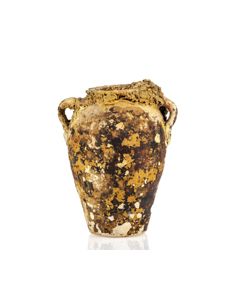 Large post-antique vase with nice sea encrustation
Large post-antique vase with nice sea encrustationPerfectly preserved. Found 1967 in the sea in Croatia, exported with permit of the local authorities.
Price: on request Large jug with nice sea encrustation
Large jug with nice sea encrustationPerfectly preserved. Found 1967 in the sea in Croatia, exported with permit of the local authorities.
Price: on request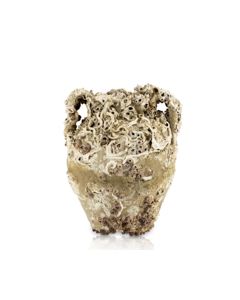 Small post-antique vase with strong sea encrustation
Small post-antique vase with strong sea encrustationNicely preserved. Found 1967 in the sea in Croatia, exported with permit of the local authorities.
Price: on request Saxon urn
Saxon urnImposing vessel made of dark clay with stamp decoration and decorative strips. A find from the Saxon Empire dating to the Early Middle Ages.
Price: on request Square bottle of thick glass
Square bottle of thick glassSmall ancient glass flask, like they are found along the old trade routes of the Islamic world. Such bottles were used around 1000 years ago to transport precious oils and other liquids.
Price: on request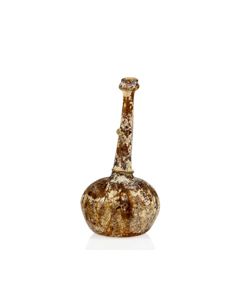 Islamic glass flask
Islamic glass flaskBulbous flask from the Golden Age of Islam. Made of beautiful reddish brown glass. Ex-Sotheby's.
Price: on request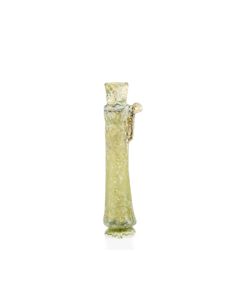 Islamic glass flask
Islamic glass flaskSlender glass flask from the Golden Age of Islam. With a nicely shaped handle and a wonderful, subtle patina. Ex-Sotheby's.
Price: on request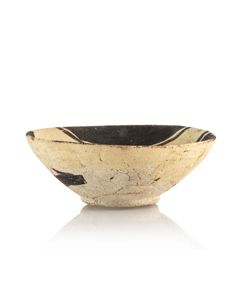 Bowl of the Chancay culture
Bowl of the Chancay cultureFlat pottery bowl with abstract painting on the inside. The pre-Columbian art of the Chancay seems simple at first, but radiates an elegance that still seems modern today.
Price: on request Roman and medieval potsherds from the Rhineland
Roman and medieval potsherds from the RhinelandFragments of Roman and medieval pottery. Finds from the Roman city of Novaesium, today's Neuss in Germany, an early Roman foundation and with this one of the oldest cities in Germany.
Price: on request Early Byzantine censer
Early Byzantine censerSmall bronze pot with a bulbous body an high handle. It was probably used as an incense burner. From the collection of the historian Friedrich von Bassermann-Jordan (1872-1959).
Price: on request Bowl of the Chancay culture
Bowl of the Chancay cultureFlat pottery bowl with abstract painting. The pre-Columbian art of the Chancay seems simple at first, but radiates an elegance that still seems modern today.
Price: on request Bowl of the Chancay culture
Bowl of the Chancay cultureThin-walled pottery bowl with abstract painting and plastic animal head handles. The pre-Columbian art of the Chancay seems simple at first, but radiates an elegance that still seems modern today.
Price: on request Bowl of the Chancay culture
Bowl of the Chancay cultureThin-walled pottery bowl with abstract painting. The pre-Columbian art of the Chancay seems simple at first, but radiates an elegance that still seems modern today.
Price: on request Gourd shaped bowl of the Chimú culture
Gourd shaped bowl of the Chimú cultureElegant bowl with shiny black surface. Precolumbian pottery of the 10th to 15th century.
Price: on request Bowl of the Chancay culture
Bowl of the Chancay cultureFlat pottery bowl with abstract painting. The pre-Columbian art of the Chancay seems simple at first, but radiates an elegance that still seems modern today.
Price: on request Bowl of the Chancay culture
Bowl of the Chancay cultureThin-walled pottery bowl with abstract painting. The pre-Columbian art of the Chancay seems simple at first, but radiates an elegance that still seems modern today.
Price: on request Persian bowl from Golestan
Persian bowl from GolestanNicely decorated with plant ornaments in black and turquoise. Made towards the end of the Islamic Golden Age in the Persian province of Golestan.
Price: on request Tall bone pyxis
Tall bone pyxisInteresting cylindrical vessel with rich decoration. From antiquity or early Middle Ages.
Price: on request Jaguar vessel of the Guanacaste-Nicoya peoples
Jaguar vessel of the Guanacaste-Nicoya peoplesThe imposing vessel shows not just a jaguar but a transformed shaman in his animal form. It was made in Pre-Columbian Mesoamerica between 800 and 1200 AD and used for funeral purposes in the Guanacaste region.
Price: on request Bavarian drinking vessel from the Early Middle Ages
Bavarian drinking vessel from the Early Middle AgesRare and beautifully stamp decorated pottery of the early Baiuvarii around 600 AD. From a find in Riekofen in Bavaria.
Price: on request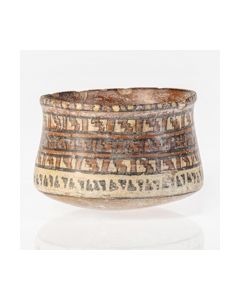 Bowl of the Ica culture
Bowl of the Ica cultureColourfully painted pottery made by the precolumbian Ica culture. Nicely decorated by five rows of ornamentation. Around 1000 AD.
Price: on request Bowl of the Ica culture
Bowl of the Ica cultureAppealing pottery made by the precolumbian Ica culture and decorated with a linear pattern. Around 1000 AD.
Price: on request Ming bowl from Binh Thuan wreck - ex Christie's
Ming bowl from Binh Thuan wreck - ex Christie'sFrom a wreck discovered 2001 in the South China Sea, identified as the Chinese merchant vessel "I Sin Ho". Perfectly preserved.
Price: on request Ming bowl from Binh Thuan wreck - ex Christie's
Ming bowl from Binh Thuan wreck - ex Christie'sFrom a wreck discovered 2001 in the South China Sea, identified as the Chinese merchant vessel "I Sin Ho". Perfectly preserved.
Price: on request Ming bowl from Binh Thuan wreck - ex Christie's
Ming bowl from Binh Thuan wreck - ex Christie'sFrom a wreck discovered 2001 in the South China Sea, identified as the Chinese merchant vessel "I Sin Ho". Perfectly preserved.
Price: on request Ming plate from Binh Thuan wreck - ex Christie's
Ming plate from Binh Thuan wreck - ex Christie'sFrom a wreck discovered 2001 in the South China Sea, identified as the Chinese merchant vessel "I Sin Ho". Perfectly preserved.
Price: on request Ming plate from Binh Thuan wreck - ex Christie's
Ming plate from Binh Thuan wreck - ex Christie'sFrom a wreck discovered 2001 in the South China Sea, identified as the Chinese merchant vessel "I Sin Ho". Perfectly preserved.
Price: on request Ming plate from Binh Thuan wreck - ex Christie's
Ming plate from Binh Thuan wreck - ex Christie'sFrom a wreck discovered 2001 in the South China Sea, identified as the Chinese merchant vessel "I Sin Ho". Perfectly preserved.
Price: on request Riesiger antiker Kochtopf, 7. bis 12. Jhd.
Riesiger antiker Kochtopf, 7. bis 12. Jhd.Eindrucksvolles Exemplar in musealer Erhaltung. Islamisch, schönes Dekor, Terracotta, Levante. Höhe: 25cm, Durchmesser: 36cm.
Price: on request Chinesische Schale mit grüner Glasur
Chinesische Schale mit grüner GlasurSchale, Keramik, grün glasiert, 15cm Durchmesser, 5cm hoch. Song Dynastie, 960 bis 1279 n.Chr., China. Glasierte Keramik, sehr schöne, dezent grünliche Glasur.
Price: on request Tempel-Ölgefäß (E)
Tempel-Ölgefäß (E)Song-Dynastie, Altes China, 960 bis 1279 n.Chr. Keramik mit brauner Glasur. Für Öl. Sehr gut erhalten.
Price: on request Chinesischer Krug mit grüner Glasur
Chinesischer Krug mit grüner GlasurKrug, 4 Henkel, 1 Ausguss, 14cm Durchmesser, 13cm hoch. Song Dynastie, 960 bis 1279 n.Chr., China. Grün glasierte Keramik in meisterhafter Ausführung.
Price: on request Tempel-Ölgefäß (A)
Tempel-Ölgefäß (A)Song-Dynastie, Altes China, 960 bis 1279 n.Chr. Keramik mit brauner Glasur. Für Öl. Sehr gut erhalten.
Price: on request Tempel-Ölgefäß (B)
Tempel-Ölgefäß (B)Song-Dynastie, Altes China, 960 bis 1279 n.Chr. Keramik mit brauner Glasur. Für Öl. Sehr gut erhalten.
Price: on request Tempel-Ölgefäß (C)
Tempel-Ölgefäß (C)Song-Dynastie, Altes China, 960 bis 1279 n.Chr. Keramik mit brauner Glasur. Für Öl. Sehr gut erhalten.
Price: on request Chinesischer Krug zum Wein erhitzen
Chinesischer Krug zum Wein erhitzenKrug, 18cm hoch. Song Dynastie, 960 bis 1279 n.Chr., China. Glasierte Keramik aus Terracotta, sehr schöne, typische grünliche Glasur. Dezente Verzierungen.
Price: on request

